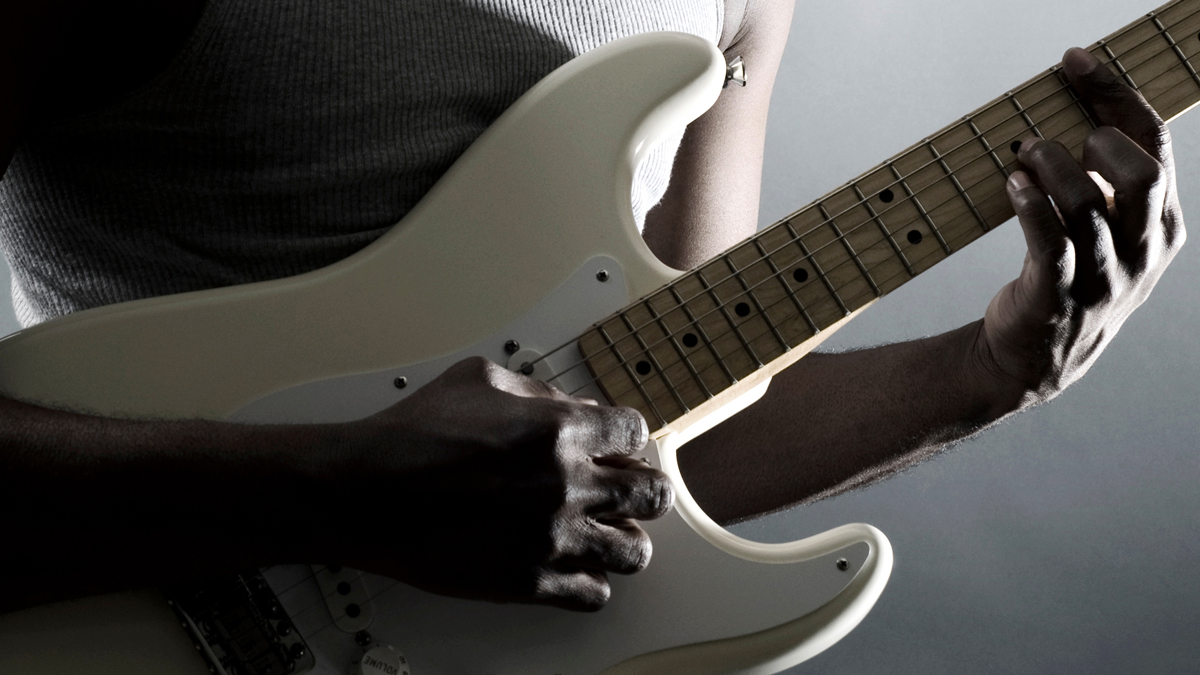Gigging guitarists spend the majority of time playing rhythm, not lead – so here are 21 ways to improve your rhythm guitar chops
Chords, picking, strumming, riffs, single-note accompaniments, timing: you can never practice rhythm playing enough, and this boot camp will hone your skills in all sorts of styles

We’ve said this many times within these pages: the majority of most performance time on electric guitar is spent playing rhythm – and, as such, it’s pretty important to practice this aspect of your playing.
Now, we don’t want to bring up the thorny subject of what constitutes rhythm guitar, and, of course, the line between rhythm and lead is somewhat blurry. Suffice to say, here in our massive lesson, we’re taking the broadest definition of rhythm guitar.
Chords, picking, strumming, riffs, single-note accompaniments, various aspects of timing and more all feature here.
And with 21 tab examples, complete with recorded audio tracks, all in different styles of music, there’s enough here to keep us all rocking until the end of the year.
Example 1. Downpicking
No surprises here! This example mixes up core punk ingredients of powerchords, palm muting and downpicking. At 160bpm, the tempo is fairly rapid, so you’ll need a steady picking motion, keeping your movements as small and focused as possible.
The thinner sounding palm-muted single notes contrast with the full chords and are a crucial punk rhythm technique. Think Ramones or Green Day and you’ll be on the right lines.
Example 2. Downpicking: ’80s thrash
There are a lot of similarities between this example and the previous one, namely the fast tempo, and the downpicked palm-muted powerchords. Once again, that means taking care to emphasise the full chords against the single notes.
All the latest guitar news, interviews, lessons, reviews, deals and more, direct to your inbox!
Typical of thrash metal rhythm though, there’s more distortion and the harmony is more complex than punk, with the Bb5 and F5 chords momentarily hinting at the Locrian mode.
Example 3. Downpicking: ’00s garage/post-punk
The turn of the century saw a post-punk and garage rock revival, with acts like The Strokes and The Hives seeing major success. Our example exploits the octave interval, and downpicking is once again the order of the day.
Dig in with a bridge pickup selected and a light overdrive tone. The sound of the guitar being hit hard and sending the amp into overdrive is more important than tickling the guitar with a higher gain setting.
Example 4. Funk chords
We’re firmly in James Brown/Jimmy Nolen territory here, with trademark 9th and 13th chords (as heard in Brown’s Get Up…) and super-tight ‘in-the-pocket’ timing. If you struggle with the rhythm, play fewer strums so that the timing is always your main focus. You can come back and perfect the riff later if you want to.
Example 5. 16th-note disco
This example is inspired by legendary disco strummer Nile Rodgers, who has been a prolific hit machine since the ’70s. For this one simply select a neck single coil pickup, dial in a lively clean tone and strum those funky 16th-note rhythms.
We recommend using a thin pick (Rodgers himself uses 0.5mm guitar picks). The flexibility just gives a smoother stroke across the strings that suits the sound of the constant 16ths.
Example 6. '90s funk-rock string muting
Here we’re taking inspiration from funk-rock greats Jane’s Addiction, Red Hot Chili Peppers and Rage Against the Machine with a combination of octaves and 16th-note strumming.
The Chilis’ John Frusciante has almost superhuman string-muting abilities (check out how he strums the two-string shapes in Scar Tissue). And though the shapes are different here, the principle is the same – so be sure to stub free fingers up against the idle strings.
Example 7. Jazz “voice leading”
This is a concept whereby the top notes (though bass or middle work, too) of a chord progression act as a melody that leads into and implies the next chord. There aren’t really any rules other than the need for your melody to catch your listener’s ear.
You can introduce new melody notes, or just let the chord tones form the tune. Check out our tab example and listen to Wes Montgomery and Joe Pass for inspiration.
Example 8. Essential fingerstyle
Our folk example combines a bassline with melody notes to create a flowing fingerpicked part. It’s a commonly used picking pattern than can be applied to countless chords and progressions.
Our advice is to spend time on the picking pattern, working with open strings first so you don’t have to worry about the changes. When you’ve got it down, try applying it to as many chords as possible.
Example 9. '70s pentatonic rock
The next example is inspired by ’70s supergroups such as Led Zeppelin and Bad Company. The E minor pentatonic scale provides a tried and tested canvas to create rock riffs. We’ve also included the b5th blue note (Bb) to add that dirty, blues rock flavour. The riff is repeated four times and finished off with a funky E9 chord.
Example 10. '80s rock
This example will help you play in the style of acts like Van Halen, Def Leppard and Bon Jovi in their ’80s pomp. Notice how we’re using the open fifth string as a repeating root note, with doublestops added on the third and fourth strings. Use palm-muting to keep the fifth string under control.
Example 11. '00s stoner metal
For this example, we wind the tempo down and lay into those low register powerchords. We’re in standard tuning here, but this is the kind of riff that’d work better played in a lower tuning or on a baritone guitar. D, C# or C standard are good starting points, or try out the “drop” equivalents where the sixth string is tuned down by a tone.
Example 12. Jimi Hendrix extended chord rhythms
Our first Jimi-style example is inspired by songs like Castles Made of Sand and Angel, and uses chords with a thumb-fretted root note on the sixth string. Another key aspect is the open third string which rings out against the moving shape sometimes in harmony and sometimes creating dissonance.
Example 13. Jimi Hendrix funk-rock
Our second example is inspired by tracks like Foxy Lady and Voodoo Chile (Slight Return), and utilises the classic 7#9 “Hendrix chord “ – a simple jazz voicing that Jimi made regular use of. Octave shapes and some ‘in-between’ lead licks complete the Hendrix package.
Example 14. Prince-style funky chords
With pop, R ’n’ B and progressive soul all part of the Prince package, funk guitar techniques are a must. The Am11 and Am13 chords we’ve used are classic Prince-style fingerings. We’d recommend experimenting with a super-clean compressed tone without any reverb for that direct, dry funk sound.
Example 15. Prince-style rock riffs
For our second Prince-inspired example, we head into the world of rock. Prince was a great rock guitarist and was no stranger to the overdrive pedal. We’ve used the A minor pentatonic scale (A C D E G) to create a chorus-style riff that would work alongside our previous funky verse example.
Example 16. Prog metal polyrhythms
The ’90s saw the worlds of prog and metal collide, with the rise of now-iconic bands Dream Theater and Tool, from whom we’ve taken inspiration here.
Our riff uses a quarter-note triplet rhythm played against a straight eighth-note groove to set up a polyrhythmic effect. To maintain the prog factor we’re swapping time signature every bar, so count to four, then two, then four, then two again to keep time.
Example 17. Drop D alt-metal
Think Soundgarden and Alice in Chains and you’ll be in the ballpark here – drop D tuning has been used in tracks such as Outshined and Them Bones respectively. Simply drop your sixth string’s pitch down a tone to D, dial in a chunky, high-gain tone and rock out with the one-finger powerchord shapes shown here.
Example 18. Contemporary math-rock strumming
The past few years have seen math-rock evolving greatly, with virtuoso acts like Chon, Covet, Polyphia and Unprocessed treading new ground.
We’re keeping things simple here, taking a look at some simple chord playing in odd time – specifically 7/4. This means there are seven quarter-note beats in each bar. Aim to make the 16th note strumming snappy and tight.
Example 19. ’80s indie arpeggios
This ’80s indie-style example is inspired by bands like The Stone Roses and The Smiths and exploits the chorus effect to add depth and lushness to the clean arpeggios.
To emulate the sounds in our example you will need a chorus pedal and a good base clean tone. Try using an ‘in-between’ pickup setting (position 2 or 4 on a five-way Fender-style selector, or position 2 on a three-way Gibson unit) for some 1980s’ indie jangle!
Example 20. Dance-rock arpeggios
Delay and chorus effects are combined here to create a spacious, modern vibe. This works well on dance tracks and our example is inspired by bands like Bloc Party and Walk the Moon.
This part is relatively simple to play and uses the trick of having the bassline change to provide a different harmonic context to the arpeggios, which remain the same.
Example 21. Classic delay
A delay effect can be used to superimpose rhythms into the guitar part. The optimum delay setting for this one is to have one delay with the repeats set to a dotted quaver and another set to a crotchet setting.
Some modern delay pedals have this feature built in, which, though a useful shortcut, can be confusing. You’d tap a crotchet note pulse for the repeats to sound with a dotted eighth timing.
Jon Bishop is a UK-based guitarist and freelance musician, and a longtime contributor to Guitar Techniques and Total Guitar. He's a graduate of the Academy of Contemporary Music in Guildford and is touring and recording guitarist for British rock 'n' roll royalty Shakin’ Stevens.






















